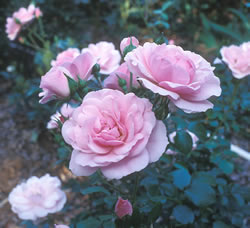
The “Bonica” rose is a nice little rose for gardeners that would like to have roses in their garden, but would like one that can withstand little maintenance, and is fairly hardy.
Not only is the Bonica rose hardy from zones four and up, but it’s also disease resistant, , very colorful, carefree and be planted as a hedge, specimen, or focal point.
The Bonica rose was voted the World’s Favorite Rose in 1997 by the World Federation of Rose Societies, and an All America Winner in 1987.
‘Bonica’ is a lively rose of low, spreading habit.
It produces large sprays of cupped, fully double, rose-pink flowers with glossy, rich green foliage. Also known as Rosa Meidonomac.
This lovely rose grows to a height of 3 to 4 feet with a width of 1 to 4 feet.
- Bloomtime Range: Mid Spring to Mid Fall
- USDA Hardiness Zone: 4 to 9
- AHS Heat Zone: 3 to 9
- Light Range: Sun to Full Sun
- pH Range: 4.5 to 8
- Soil Range: Sandy Loam to Clay Loam
- Water Range: Normal to Moist
 Depending on what area of the world you are growing Datura it can be classed as a perennial or a tropical annual – meaning that it only survives the winter months in warm zones. It’s hardy to USDA Zone 9b: to -3.8° C (25° F). The plant grows 18″ to 24 ” in height, but has a tendency to spread out, so if you grow Datura allow at least a four foot diameter around the plant for growth.
Depending on what area of the world you are growing Datura it can be classed as a perennial or a tropical annual – meaning that it only survives the winter months in warm zones. It’s hardy to USDA Zone 9b: to -3.8° C (25° F). The plant grows 18″ to 24 ” in height, but has a tendency to spread out, so if you grow Datura allow at least a four foot diameter around the plant for growth. Some species of Datura bloom at night. Mine tend to bloom in the late afternoon on ward with the flowers closing in bright light. They do need full sun to grow properly even if they tend to only show their beauty at night. The flowers are large and lush and tend to face upward. They bloom from early summer to mid Fall.
Some species of Datura bloom at night. Mine tend to bloom in the late afternoon on ward with the flowers closing in bright light. They do need full sun to grow properly even if they tend to only show their beauty at night. The flowers are large and lush and tend to face upward. They bloom from early summer to mid Fall.


 Actually both the Thanksgiving Cactus and Christmas Cactus are known to bloom twice a year, with the first blooms of the Thanks Giving cactus between October and November and the second between February and March, while the Christmas Cactus tends to bloom in December and January, and then again in April or May.
Actually both the Thanksgiving Cactus and Christmas Cactus are known to bloom twice a year, with the first blooms of the Thanks Giving cactus between October and November and the second between February and March, while the Christmas Cactus tends to bloom in December and January, and then again in April or May.
